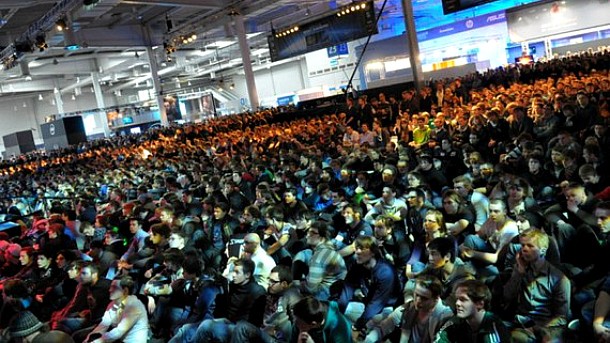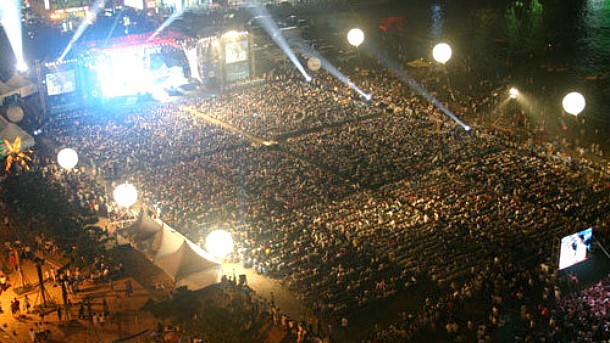Please support Game Informer. Print magazine subscriptions are less than $2 per issue
Why Should You Care About eSports?

What makes over eight million people tune in to live streams to watch other people play video games? Electronic Sports, better known as eSports, is an umbrella term for competitive video gaming. Competitive gaming has been growing in popularity for a while now, developing a large fan-base that is both loyal and rabid for more content. The millions of people who tune in to eSports events can’t be bored to tears, right? What makes them fun?
At its heart, eSports are about competing against other people, just like football, baseball, or chess. The players might not be running around a field or attempting to set a world-record race time, but appearances can be deceiving. The games that become popular in eSports, like League of Legends, StarCraft 2, Counter-Strike, Soul Caliber V, etc. have huge learning curves and take hundreds if not thousands of hours to master. To become one of the best in any of these games takes dedication and commitment. Playing any of these games competitively involves extreme mental fortitude and lightning-quick reflexes. There are success stories and falls from grace, rivalries and friendships, heartbreaking losses, and unbelievable victories. Yes, all of these things take place on a screen instead of on a field, but why should that matter? The skill is there. The heart is there. The entertainment is there. The audience is also there, and it is growing.
In the last ten years, eSports have become huge. They have always been big in South Korea, but wide acceptance has been a slow process in North America. The focus on competitive gaming in major publisher press conferences at E3 this year demonstrated eSports’ growing mainstream appeal. Major League Gaming (MLG), a driving force behind this growth, is an organization that fosters player competition through various events and expos, provides over 750,000 matches every month, and live tournaments in cities around the United States. These matches attract thousands of spectators and millions of online viewers who watch as the events are streamed live over the Internet. Over eight million people watch MLG’s video content every month. Gaming isn’t niche any more, and with numbers like that, neither is pro gaming.

With 4.7 million people viewing and over 5.4 million hours of video consumed over the course of the 2012 MLG Pro Circuit Spring Championship from June 8-10, it is safe to say that eSports are popular. What draws this interest in virtual competition? Three elements make up the core appeal of eSports: the games, the casters, and the skill level.
Having an interesting game to watch makes for a more enjoyable experience. The real-time strategy, first-person shooter, and fighting genres make up the bulk of eSports competition. StarCraft 2 has been a consistent favorite over the years due to its deep strategy, learning curve, tight gameplay, and beautiful graphics. Multiplayer Online Battle Arena (MOBA) games like League of Legends have surged in popularity recently due to their team-based nature, high skill cap, and ease of entry. FPS games like Counter-Strike and the Halo franchise thrive on twitchy play, fast reactions, and pinpoint accuracy. The fighting genre harkens back to the arcade style of gameplay. Mortal Kombat, Soul Caliber V, and Street Fighter IV all play pivotal roles in tournaments and draw crowds through the thrill of huge combos, blocks, and split-second timing on display from world-class players.
Casters, the people who talk about and give commentary on the game in-progress, are also key to the eSports experience. Their charisma and approachability, combined with the clear and concise delivery of information, enables people who would not otherwise enjoy watching gamers compete on the virtual battlefield to understand and appreciate the action on-screen. Professional casters like Sean Plott (aka Day[9]), Nicholas Plott (aka Tasteless), Daniel Stemkoski (aka Artosis), Marcus Graham (aka djWHEAT), Chris Puckett, and more all provide an entertaining, clear, and smooth running commentary that helps generate interest in eSports.
The skill that the professionals need to have to play these games is incredible. Pro players need to train for hours every day to keep their edge over rivals and upcoming hopefuls. Players work on mouse accuracy, reflex time, decision-making, pulling off difficult maneuvers, and becoming the best of the best in their game of choice. Some professional players quit their jobs and make their living entirely off of competition. Words really don’t do these games or players justice. Below you’ll find a few videos of some of the most intense moments that have occurred at pro tournaments over the years.
This video is from the 2004 Evolution Championship Series (EVO) between Daigo “the Beast” Umehara and Justin “Jwong” Wong in the semi-finals of the Street Fighter II Turbo (EDIT: the game was actually Street Fighter III: 3rd Strike) part of the tournament.
Essentially, Daigo manages to perfectly parry each of Justin’s attacks. In Street Fighter, a parry involves blocking at the exact time of impact and pointing your control stick in the exact position from which the attack is coming.
In a game of StarCraft 2 anything can happen. This game is from the GOMTV StarCraft Open (GSL) Code S (the highest skill level). The clip below shows the last five minutes of a close matchup between MVP and Squirtle. MVP has a ton of battlecruisers (the strongest unit he can make) and Squirtle makes a blunder splitting his forces. An unbelievable demonstration of quick strategic thinking ensues.
Counter-Strike has always been a popular FPS in the competitive scene. The video below, though not a full match, showcases some ridiculously quick headshots and well-placed grenades of the sort you can expect from typical professional level play in the FPS genre.
This game is a full best-of-three matchup from the IEM Kiev Grand Final between Team SoloMid and Moscow Five in League of Legends. The gameplay is fantastic and the casting is excellent at explaining what is going on. Game 1 starts at 25:23 and Game 2 begins at 1:16:09. Be warned, this is an extremely long video.
Why should you care about eSports? Because they are so dang fun to watch.
I hope that I have stirred up some interest in the competitive gaming scene, or at least opened it up for discussion. Over the coming months, I’ll be posting more content related to eSports, specifically covering the MLG Summer Season. You can expect to see overviews of some of the biggest eSports titles, interviews, event coverage, and more as the season rolls on.










